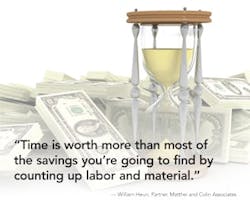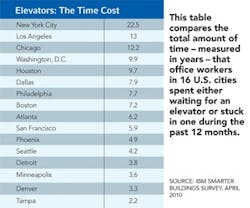Newsworthy
In Construction, Time Really is Money
In a construction project, people aren’t kidding around when they say that wasting time can mean wasting money. William Heun, partner at Matthei and Colin Associates, discusses how to keep your budget down by communicating effectively to save time.
BUILDINGS: How does teamwork impact construction costs in terms of time and money?
Heun: It has a lot to do with communication. The traditional view of construction management is very adversarial. With a $150 million project (in terms of construction costs), it’s actually a $200 million project in terms of total cost. The debt service will be $50,000 per day, or $1.5 million per month. Obviously, time is what’s important, and clear communication saves time. Everyone sitting at the table and working the problem – instead of working their agendas – is what it’s all about. I always think of it in terms of the debt service per month.
BUILDINGS: How should facilities professionals effectively manage construction schedules?
Heun: Perhaps most important is to schedule not only construction activities (which is the construction manager’s job), but the work of the other constituents, from the design team to the move consultant. One of the things that is most productive to schedule is the shop drawing or submittal release from the contractors – to match the shop drawings with when the products are fabricated or needed. It’s especially important on a large job – you could have a full-year lag from the start of one activity until the end of that activity.
With a 500,000-square-foot project, you might be hanging doorframes and putting up stud walls while you’re doing foundations and steel work. You need to schedule the release and review of critical information to match up with the real-time need of the information. There’s a variety of very powerful scheduling software, and it can be very detailed. Use good software, and make sure one entity is responsible for maintaining it. .
BUILDINGS: How do you go about building a resolution to a construction problem?
Heun: First, deal with the problem before you deal with the blame. In other words, solve the problem before you figure out who owns the problem. Second, go back to communication. Very few problems are owned by a single person in a construction project, and very few problems are going to be solved by a single entity, so it’s critical that the people who are empowered to make decisions are working on the problem as you try to solve it. One of the rally killers is to have people there who aren’t empowered to make decisions.
BUILDINGS: What is an acceptable way to communicate early in the project to help control costs?
Heun: Even before the project is under construction, have your construction manager and design team working together to determine the best way to go about construction. For large projects, a professional construction coordinator is critical for determining how long it’s going to take to build, the cost benefits of one system or finish vs. another, etc.
BUILDINGS: What are the best ways to save money on construction costs?
Heun: I would assert that, other than gross negligence or mismanagement, the single biggest thing to pay attention to is schedule – time is worth more than most of the savings you’re going to find by counting up labor and material. Paying attention to keeping the schedule and getting the project done in the shortest amount of time is probably the biggest way to save money.
Inefficiencies built into office buildings take a toll on lost productivity and added costs, according to the IBM Smarter Buildings study (a survey of more than 6,000 office workers in 16 U.S. cities).
In the past 12 months, office workers across the surveyed cities spent a total of 33 years stuck in elevators. New York City office workers spent a total of 5.9 years stuck in elevators in the last 12 months, while office workers in Minneapolis/St. Paul spent half a year.
Workers spent nearly three times as long waiting for elevators in the past 12 months; waiting time was a total of 92 years across the 16 cities. New York City office workers spent 16.6 years waiting; those in Minneapolis/St. Paul spent 3.1 years. Of those surveyed, 25 percent said the elevators in their office buildings are poorly coordinated (insufficient capacity, etc.).
Only one-third rated their office buildings as “somewhat high,” “very high,” or “extremely high” when it comes to environmental responsibility; nearly two-thirds say they would participate in the redesign of their office workspace to make it more environmentally responsible.
The survey also found that 79 percent of respondents conserve resources as part of their work routines; nearly the same percentage say they would be more likely to conserve if they were rewarded. To read more from the complete report, click here.
Facilities professionals play a crucial role in making contributions to America’s economic and environmental security, as buildings and their construction account for almost half of greenhouse-gas emissions and energy consumption in the country, according to AIA President George Miller.
“Bills have been introduced this Congressional session that command broad bipartisan support and could help create hundreds of thousands of jobs in the design and construction industries – and go a long way toward curbing energy use,” says Miller. “Our industry has the will to make that contribution. What we need are the tools.”
Several pieces of legislation are proceeding through stages of the process, including:
- S 3079, which creates a federal program known as Building STAR. It allows building owners to receive rebates and low-cost financing options for energy-efficient renovations in existing buildings. The AIA estimates that Building STAR would create 25,000 jobs in 2010 for every $1 billion of federal investment, and 150,000 jobs with a $6 billion investment.
- HR 2187, the 21st-Century Green High-Performing Public School Facilities Act, which was passed by the House in May 2009. It provides $6.4 billion in grants for states and local governments to modernize schools. The AIA estimates that 100,000 jobs will be preserved or created by this bill.
- Representative Mike Thompson (D-CA) introduced legislation that amends the Internal Revenue Code, allowing tax exemption of the interest on bonds (like PACE bonds) issued to finance renewable energy resource facilities, conservation and efficiency facilities and projects, and zero-emission vehicles and related facilities or projects.
Clean Restrooms = Happy Workers
Office workers may aspire for a promotion or a window in their office, but their aspirations for the restrooms in their offices aren’t as lofty.
Six out of 10 office workers are just longing for a clean bathroom at work, according to the results of a survey conducted by Infogroup/ORC on behalf of Kimberly-Clark Professional. Other survey results:
- Only 38 percent of respondents described their workplace restrooms as “always super-clean.”
- Twenty-six (26) percent said that visiting the restroom was “a 50-50 gamble – sometimes clean, other times a disaster.”
- One-quarter said that office restrooms weren’t as clean as the restrooms in their homes.
Also according to this survey, the products used in office restrooms are just as important as cleanliness. Eighty-three (83) percent of participants said they would notice if management switched from a quality tissue, towel, or soap to an inferior version; only 17 percent said they wouldn’t notice.
Is LEED as Expensive as It Seems?
Even with the benefits of LEED, many people choose not to pursue certification because it’s viewed as prohibitively expensive. But in many cases, the cost isn’t as prohibitive as it seems.
To close the gap between perception and reality, Tsoi/Kobus & Associates instigated a two-year study to analyze cost premiums associated with LEED certification. The Cost of LEED, a culmination of the study, examines the financial and functional synergies of LEED strategies, providing users with a menu of options that help them select a combination of strategies.
This study draws from the resources and experiences of veteran cost estimators to present the cost of specific measures that a team is likely to consider for their building. Previously published studies have taken more of an aggregated approach, trying to predict overall cost impact of LEED from looking at previous projects.
More than 30 Federal Programs Set to Enhance Energy Efficiency
The current administration is authorized to play a more active and supportive role in progressing the energy efficiency and sustainability of America’s multi-family and commercial building stock, according to Using Executive Authority to Achieve Greener Buildings: A Guide for Policymakers to Enhance Sustainability and Efficiency in Multifamily Housing and Commercial Buildings, a report released by BOMA, the USGBC, and other organizations.
The report concluded that, under current executive authority, the Obama Administration has the ability to use more than 30 existing federal programs worth almost $72 billion to enhance efficiency in commercial buildings and multi-family housing – with no new legislation.
An extensive menu of options across an array of programs, which the administration could begin to implement immediately without seeking new funds or authority from Congress, is presented in the report. Some of the most promising options include:
- Greening federal banking regulations.
- Promoting Flexibly FHA insurance products, especially Section 241.
- Integrating energy efficiency and sustainability criteria into competitive grants and funding formulas.
- Strengthening minimum property standards for federal housing and economic development programs to reflect energy efficiency and sustainability standards.
- Improving performance standards applicable to federal buildings and leases.
- Refining guidance applicable to energy-efficient commercial buildings tax deduction and the national preservation tax credit.
- Using SBA funding mechanisms to support energy-efficiency investments for small businesses.
- Streamlining Title 17 loan guarantees to make them suitable for buildings.
To download the full report, click here.





